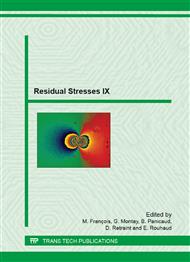[1]
D. R. Lesuer, C. K. Syn, O. D. Sherby, J. Wadsworth, J. J. Lewandowski, W. H. Hunt Jr, Mechanical behaviour of laminated metal composites, Int. Mat. Rev. 41 (1996) 169-197.
DOI: 10.1179/imr.1996.41.5.169
Google Scholar
[2]
F. Findik, Recent developments in explosion welding, Mater. Design 32 (2011) 1081-1093.
Google Scholar
[3]
S.A.A. Akbari-Mousavi, L.M. Barrett, S.T.S. Al-Hassani, Explosion welding of metal plates, J. Mater. Process. Tech. 202 (2008) 224-239.
DOI: 10.1016/j.jmatprotec.2007.09.028
Google Scholar
[4]
R.A. Patterson, Fundamentals of Explosion Welding, in: D. L. Olson, T. A. Siewert, S. Liu, G. R. Edwards (Eds. ), ASM Handbook: Volume 6: Welding Brazing and Soldering, ASM International, Ohio, (1993).
DOI: 10.31399/asm.hb.v06.a0001351
Google Scholar
[5]
S. A. Akbari-Mousavi, S. T. S. Al-Hassani, Numerical and experimental studies of the mechanism of the wavy interface formations in explosive/impact welding, J. Mech. Phys. Solids 53 (2005) 2501-2528.
DOI: 10.1016/j.jmps.2005.06.001
Google Scholar
[6]
A.S. Bahrani, T.J. Black, B. Crossland, The mechanics of wave formation in explosion welding, P. Roy. Soc. Lond. A Mat. 296, 1967, 224-239.
Google Scholar
[7]
E. P. Pokataev, Y. P. Trykov, A. S. Kraev, Calculations and experimental determination of residual deflections of bimetallic components produced by explosion welding, Weld. Int. 13 (1999) 482-484.
DOI: 10.1080/09507119909447400
Google Scholar
[8]
W. Yasheng, C. Hongneng, M. Ninxu, Measurement of residual stresses in a multi-layer explosion welded joint with successive milling technique, Strain 35 (2008) 7-10.
DOI: 10.1111/j.1475-1305.1999.tb01112.x
Google Scholar
[9]
M. Sedighi, M. Honarpisheh, Experimental study of through-depth residual stress in explosion welded Al-Cu-Al multilayer, Mater. Design 37 (2012) 577-581.
DOI: 10.1016/j.matdes.2011.10.022
Google Scholar
[10]
A. Karolczuk, K. Kluger, M. Kowalski, F. Zok, G. Robak, Residual stresses in steel-titanium composite manufactured by explosive welding, Mat. Sci. Forum 726 (2012) 125-132.
DOI: 10.4028/www.scientific.net/msf.726.125
Google Scholar
[11]
Y. Taran, A. M. Balagurov, B. Sabirov, V. Davydov, A. M. Venter, Neutron diffraction investigation of residual stresses induced in niobium-steel bilayer pipe manufactured by explosive welding, Mat. Sci. Forum 768-769 (2014) 697-704.
DOI: 10.4028/www.scientific.net/msf.768-769.697
Google Scholar
[12]
B. Mateša, D. Kozak, A. Stoić, I. Samardžić, The influence of heat treatment by annealing on clad plates residual stresses, Metalurgjia, 50 (2011) 227-230.
Google Scholar
[13]
M. Honarpisheh, M. Asemabadi, M. Sedighi, Investigation of annealing treatment on the interfacial properties of explosive-welded Al/Cu/Al multilayer, Mater. Design 37 (2012) 122-127.
DOI: 10.1016/j.matdes.2011.12.045
Google Scholar
[14]
F. Findik, R. Yilmaz, T. Somyurek, The effects of heat treatment on the microstructure and microhardness of explosive welding, Sci. Res. Essays 6 (2011) 4141-4151.
DOI: 10.5897/sre11.1018
Google Scholar
[15]
B. López, I. Gutiérrez, J. J. Urcola, Study of the microstructure obtained after diffusion bonding Inconel 625 to low alloy steel by hot uniaxial pressing or hipping, Mater. Charact. 28 (1992) 49-59.
DOI: 10.1016/1044-5803(92)90028-g
Google Scholar
[16]
H. R. Zareie Rajani, S. A. A. Akbari Mousavi, E. Madani Sani, E., Comparison of corrosion behavior between fusion cladded and explosive cladded Inconel 625/plain carbon steel bimetal plates, Mater Design 43 (2012) 467-474.
DOI: 10.1016/j.matdes.2012.06.053
Google Scholar
[17]
T. E. Abioye, J. Folkes, A. T. Clare, A parametric study of Inconel 625 wire laser deposition, J. Mater. Proc. Technol. 213 (2013) 2145-2151.
DOI: 10.1016/j.jmatprotec.2013.06.007
Google Scholar
[18]
E. Macherauch, P. Müller, Das sin2ψ-Verfahren der röntgenoraphischen Spannungsmessung, Z. Angew. Physik, 13 (1961) 305-312.
Google Scholar
[19]
A. Szecket, O. T. Inal, D. J. Vigueras, J. Rocco, A wavy versus straight interface in the explosive welding of aluminum to steel, J. Vac. Sci. Technol. 3 (1985) 2588-2593.
DOI: 10.1116/1.572839
Google Scholar
[20]
R. Mendes, J.B. Ribeiro, A. Loureiro, Effect of explosive characteristics on the explosive welding of stainless steel to carbon steel in cylindrical configuration, Mater. Design 51 (2013) 182-192.
DOI: 10.1016/j.matdes.2013.03.069
Google Scholar
[21]
M. R. Khanzadeh, S. A. A. Akbari Mousavi, A. Amadeh, G. H. Liaghat, Correlation between numerical finite element simulation and experiments for explosive cladding of nickel base super alloy on hot tool steel, Strain 48 (2012) 342-355.
DOI: 10.1111/j.1475-1305.2011.00828.x
Google Scholar


